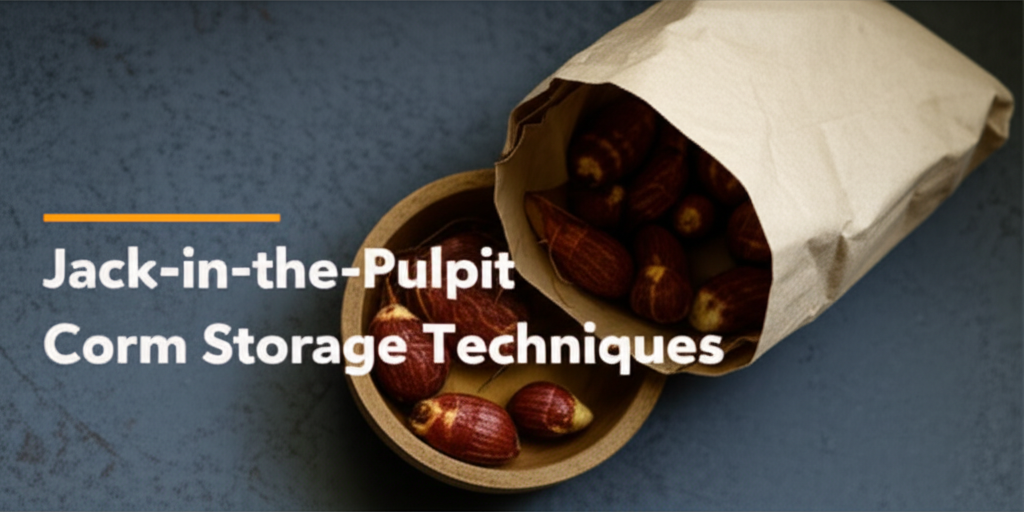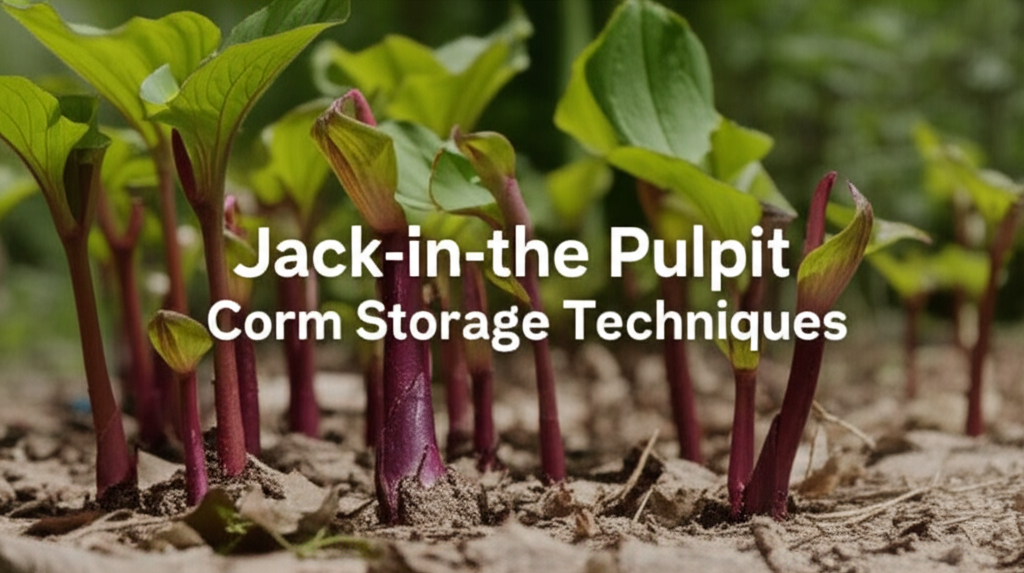Introduction: Preserving the Magic of Jack-in-the-Pulpit
Jack-in-the-Pulpit (Arisaema triphyllum) is a beloved native woodland perennial, instantly recognizable by its unique, hooded spathe and spadix. While its beauty is ephemeral in the garden, its underground corm holds the promise of future blooms. Proper storage of these corms is crucial for their survival and successful replanting, especially for gardeners who wish to propagate, divide, or simply protect these fascinating plants from harsh winter conditions. This comprehensive guide will delve into the essential techniques for storing Jack-in-the-Pulpit corms, ensuring their viability and setting you up for a spectacular display in the coming seasons.
Understanding the Jack-in-the-Pulpit Corm

Before diving into storage techniques, it’s important to understand what we are storing. The Jack-in-the-Pulpit corm is a modified stem that grows underground. It serves as a food reserve, allowing the plant to survive dormant periods, such as winter or extended drought. These corms are fleshy and can be susceptible to drying out, rotting, or pest damage if not stored correctly. They typically form a flattened, disk-like structure with a central growing point and can vary in size from a small marble to several inches in diameter, depending on the age and health of the plant.
When to Harvest Corms
The timing of corm harvesting is critical for success.
- After Foliage Dies Back: The ideal time to excavate Jack-in-the-Pulpit corms is in the late autumn, after the above-ground foliage has completely withered and turned yellow or brown. This indicates that the plant has finished its growing cycle and has stored sufficient energy in the corm for the next season.
- Avoid Premature Harvesting: Harvesting before the foliage dies back can result in smaller, weaker corms that are less likely to survive storage.
- Allow for Natural Dormancy: It’s generally best to let the plant experience its natural dormancy period in the ground. Digging them up prematurely can disrupt this process.
Excavation and Initial Preparation
The process of carefully removing the corms from the soil is the first step in successful storage.
Digging Up the Corms
- Use a Garden Fork or Trowel: Gently insert a garden fork or trowel into the soil a few inches away from the base of the plant. Work your way around the plant, loosening the soil to avoid damaging the corm.
- Lift Carefully: Once the soil is loosened, carefully lift the entire clump, including the corm and any surrounding soil.
- Shake Off Excess Soil: Gently shake off as much excess soil as possible. Avoid washing the corms at this stage unless they are heavily encrusted with mud.
Cleaning and Inspection
Once excavated, the corms require a thorough cleaning and inspection.
- Gentle Brushing: Use a soft brush or your fingers to remove any remaining soil.
- Inspect for Damage or Disease: Examine each corm for signs of rot, insect damage, or disease. Discard any corms that show significant damage or signs of spoilage to prevent it from spreading to healthy corms.
- Trim Roots (Optional but Recommended): If there are any large, fleshy roots attached, you can trim them back to about an inch. This can help prevent fungal growth during storage.
Storage Techniques: Keeping Your Corms Healthy
Several methods can be employed for storing Jack-in-the-Pulpit corms, each with its advantages. The key is to provide conditions that mimic their natural dormant state while protecting them from extremes.
Method 1: The Peat Moss or Vermiculite Method
This is a widely recommended and highly effective method for storing corms, as it helps maintain consistent moisture levels without allowing the corms to become waterlogged.
Steps:
- Prepare the Container: Select a breathable container such as a wooden crate, a cardboard box with ventilation holes, or a plastic bin with air holes.
- Layer the Medium: Place a layer of slightly damp (not wet) peat moss or vermiculite at the bottom of the container.
- Arrange the Corms: Place the cleaned and inspected Jack-in-the-Pulpit corms on top of the medium, ensuring they are not touching each other.
- Cover the Corms: Gently cover the corms with another layer of damp peat moss or vermiculite, ensuring they are completely enclosed.
- Add More Layers (if necessary): Continue layering corms and medium until the container is full or all corms are stored.
- Label and Store: Label the container with the date and variety (if known). Store in a cool, dark place.
Method 2: The Paper Bag Method
This method is simpler and can be effective for shorter storage periods or in environments where humidity is more easily controlled.
Steps:
- Ensure Corms are Dry: Allow the corms to air dry for a day or two after cleaning to reduce surface moisture.
- Place in Paper Bag: Put the dry corms into a sturdy paper bag. Avoid overfilling the bag.
- Fold and Seal: Fold the top of the bag securely. You can staple it or fold it multiple times.
- Label: Clearly label the bag with the contents and date.
- Store: Place the paper bag in a cool, dark location.
Method 3: Refrigeration (with Caution)
Refrigeration can be an option, but it requires careful management to prevent excessive drying or exposure to ethylene gas.
Steps:
- Wrap Corms: Wrap each individually cleaned corm in a paper towel or newspaper.
- Place in an Airtight Container: Put the wrapped corms into a loosely sealed plastic bag or a container that allows for some air circulation.
- Avoid Ethylene-Producing Fruits: Do not store with fruits like apples or bananas, as ethylene gas can damage the corms.
- Monitor Regularly: Check the corms weekly for signs of drying or mold.
Ideal Storage Conditions
Regardless of the method chosen, maintaining the right environmental conditions is paramount for successful corm storage.
Temperature
- Cool is Key: The ideal storage temperature for Jack-in-the-Pulpit corms is between 35°F and 45°F (2°C and 7°C). This mimics the cool, stable temperatures of the underground environment during winter.
- Avoid Freezing: Temperatures below freezing can damage the delicate tissues of the corm.
- Avoid Warmth: Temperatures above 50°F (10°C) can encourage premature sprouting or fungal growth.
Humidity
- Moderate Humidity: A slightly humid environment is beneficial to prevent the corms from drying out. Aim for around 50-70% relative humidity.
- Avoid Wetness: Excessive moisture can lead to rot. If using the peat moss method, ensure the medium is only slightly damp.
Ventilation
- Airflow is Important: Good air circulation helps prevent the buildup of moisture and reduces the risk of fungal diseases. This is why breathable containers are recommended.
- Check Regularly: Even with good ventilation, it’s important to periodically inspect stored corms.
Light
- Darkness is Best: Jack-in-the-Pulpit corms should be stored in complete darkness. Exposure to light can stimulate unwanted growth.
Monitoring and Maintenance During Storage
Regular checks are essential to ensure the health of your stored corms and to catch any potential problems early.
- Weekly Inspections: Check your stored corms at least once a week.
- Look for Signs of Trouble: Keep an eye out for:
- Mold or Fungus: Discard any corms showing signs of mold. If mold is present on the storage medium, remove it and replace it if necessary.
- Shriveling: If corms appear excessively dry and shriveled, slightly dampen the storage medium (if applicable) or re-wrap them.
- Sprouting: If corms start to sprout prematurely, especially in warmer temperatures, you may need to move them to a cooler location or consider planting them earlier.
- Remove Damaged Corms: Immediately remove any corms that show signs of rot or damage to prevent it from spreading.
When to Plant Stored Corms
The decision of when to plant your stored Jack-in-the-Pulpit corms depends on your climate and desired blooming time.
- Spring Planting: The most common time to plant is in the early spring, typically 4-6 weeks before the last expected frost. This allows the corms to establish before the warmer weather arrives.
- Fall Planting (in milder climates): In regions with mild winters, fall planting is also an option. This allows the corms to overwinter in the ground and may result in earlier blooms the following spring.
- Consider Dormancy Break: While Jack-in-the-Pulpit corms naturally go dormant, bringing them out of storage and planting them in spring provides them with a consistent environment for growth.
Troubleshooting Common Storage Issues
Even with the best intentions, storage issues can arise. Here are some common problems and their solutions.
Problem: Corms are Rotting
- Cause: Too much moisture, poor ventilation, or presence of disease.
- Solution:
- Ensure corms are thoroughly dry before storing.
- Use breathable containers and a storage medium that is only slightly damp.
- Improve ventilation in your storage area.
- Discard all rotted corms immediately.
- If mold is present, you can try to salvage healthy parts of the corm by cutting away the rotten sections and allowing the cut surfaces to dry thoroughly before re-storing in a new, clean medium.
Problem: Corms are Drying Out and Shriveling
- Cause: Storage environment is too dry, or the corms were not adequately packed in their medium.
- Solution:
- If using peat moss or vermiculite, slightly dampen the medium.
- Ensure corms are fully covered by the storage medium.
- Consider placing a shallow tray of water near the storage container (not in direct contact) to increase ambient humidity.
Problem: Premature Sprouting
- Cause: Storage temperatures are too warm, or there is too much light exposure.
- Solution:
- Move the corms to a cooler location within the ideal temperature range.
- Ensure the storage area is completely dark.
- If sprouting is significant, consider planting them a bit earlier than planned.
Key Facts and Comparison of Storage Methods
This table provides a quick overview of the different storage techniques and their key attributes.
| Feature | Peat Moss/Vermiculite Method | Paper Bag Method | Refrigeration Method |
|---|---|---|---|
| Moisture Control | Excellent (maintains consistent, moderate dampness) | Fair (depends on ambient humidity) | Variable (requires careful wrapping) |
| Ease of Use | Moderate | Easy | Moderate (requires more monitoring) |
| Protection from Drying | Very Good | Fair | Good (if wrapped properly) |
| Protection from Rotting | Good (with proper dampness) | Fair (risk increases if corms are not dry) | Fair (risk increases if condensation occurs) |
| Cost | Low (peat moss/vermiculite are inexpensive) | Very Low | Low (uses existing refrigeration) |
| Ideal for | Long-term storage, varying climates | Shorter-term storage, controlled environments | Short to medium-term storage, requires careful monitoring |
Steps, Pros, and Cons Summary
Here’s a breakdown of the steps, advantages, and disadvantages of each storage method.
| Method | Key Steps | Pros | Cons |
|---|---|---|---|
| Peat Moss/Vermiculite | 1. Prepare breathable container. 2. Layer damp medium. 3. Arrange corms (not touching). 4. Cover with medium. 5. Label and store cool/dark. |
|
|
| Paper Bag | 1. Ensure corms are dry. 2. Place in sturdy paper bag. 3. Fold and seal bag. 4. Label and store cool/dark. |
|
|
| Refrigeration | 1. Wrap corms individually. 2. Place in loosely sealed container. 3. Store away from fruits. 4. Monitor regularly. |
|
|
Conclusion: Successful Storage for Future Blooms
Storing Jack-in-the-Pulpit corms is a rewarding practice that allows you to preserve these unique native plants, share them with others, or experiment with propagation. By understanding the needs of the corm during its dormant period – cool temperatures, moderate humidity, darkness, and good ventilation – you can implement simple yet effective storage techniques. Regular monitoring is key to success, enabling you to address any issues promptly and ensure your Jack-in-the-Pulpits are healthy and ready to emerge and delight you with their distinctive floral displays come spring. Happy storing and happy gardening!


